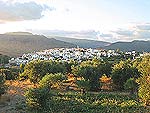
Kapsa
|
Folklore - Saints |
||
|
Gerontogiannis
|
| Ioannis Vizentsos, later known as Gerontogiannis or Osios Iosif, was born in 1799, while his parents visited the Kapsa monastery on the southeast coast of Crete. | |||
| As Ioannis grew up, he proved to be a proud and self-willed young man, and in order to avoid episodes with the Turks in Lithines, the family's hometown, his father sent him away to distant places to herd sheep. | |||
 |
A Greek family with two very beautiful daughters lived in Lithines. A local Turk forced the oldest daughter to marry him, and in order to avoid the same misfortune coming upon the youngest daughter, Kalliopi, she was sent away to the south coast, until she and Ioannis could get married. At the marriage Ioannis took the girl's surname, Gerontakis. | ||
|
Lithines
|
|||
| They settled in
Lithines, had four children and a quiet existence until the spring of
1841, when an unexpected event would change the family's life. Without any
warning, Ioannis fell into a deep comatose sleep, which lasted for 43
hours.
|
|||
| When he woke up he
showed no sign of exhaustion or confusion, on the contrary, he seemed very
refreshed and told immediately about his dream: An angel had guided him
around in both paradise and hell and had given him the strength of being
able to perform miracles and do good deeds.
|
|||
| His first miracle was
healing an elderly woman from the village so that she was able to walk
after several years of paralysis.
|
|||
| In order to praise God for the
transformation which had happened to him, he went into the
Panagia church in Lithines, and when he after several hours of prayer came
out again, he called on the crowd who had gathered in the church square,
to be kind to each other and live in toleration.
|
|
||
| The rumour of Ioannis' healing
powers spread fast, and naturally this caused many
people to flock to Lithines - either to be cured or just to see Ioannis.
|
|||
| When the Cretans again that
year rebelled against the Turks, Ioannis was arrested several times and
taken to Iraklion, accused of inciting the masses to revolution.
|
|||
| After having healed the Turkish
commander's mother in Iraklion and the child of the local commander in
Sitia, he was, however, given permission by the authorities to continue
his practice unchallenged - but in a faraway place.
|
|||
| Also the Orthodox Church was
concerned about Ioannis' popularity at first. But during the bishop's
visit to Lithines his horse foaled and after that it became wild and
afraid of people. Nobody could get near to it, except for Ioannis, who
stroke its muzzle and the horse calmed down. After this episode, the
church allowed Ioannis to carry on his practice but it demanded - as the
Turks - that it should take place at a faraway spot.
|
|||
| In November 1841, Ioannis therefore went to the Kapsa monastery, where he had been born, baptised and married. The owner, Chatzis Nikolaos Zafeiris, placed the little monastery and some land at his disposal, free of charge. He started immediately to repair the monastery, but the work did not really speed up until 20 years later (1861-1863). | |||
|
Kapsa |
|||
| When the new church was
consecrated by bishop Harion in 1863, Gerontogiannis was simultaneously
ordained as a monk and got the name of Iosif.
|
|||
| Some years later Gerontoiannis
was sent to the Agia Sofia monastery near Chandras, northeast of Kapsa, to
lead the repair work there.
|
|||
| Not until 1870 - after more
than three years in the Agia Sofia monastery - did he get permission to
return to the Kapsa monastery, where he lived till his death, on August
6th 1874.
|
|||
| Today the earthly remains of Osios Iosif are placed in the church as a relic for
the believers.
|
|||